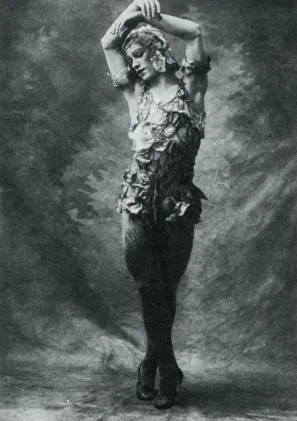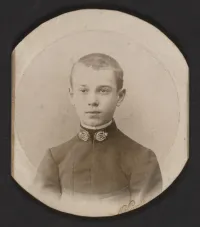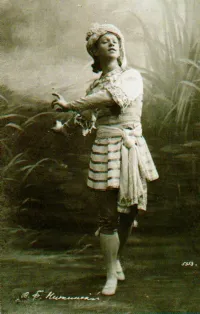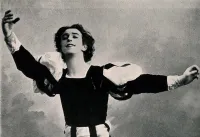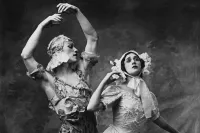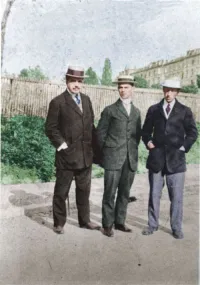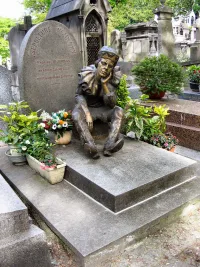Biography
1889 - 1950
“I have come to the conclusion that it is better to be silent than to speak.”
– Vaslav Nijinsky
Vaslav Nijinsky was born in Kyiv, Ukraine on March 12, 1889 to a family of celebrated dancers. At 9, he entered the preeminent ballet school in the world – the Imperial School of Dancing – where his extraordinary talent was soon apparent. Upon graduating in 1907, Nijinsky joined the Mariinsky Theatre as a soloist where, for the next three years, he danced all the male leads. Audiences and critics alike were so thrilled by his talent that, in 1909, when impresario Sergei Diaghilev launched the Ballets Russes, he asked Nijinsky to join as a principal dancer. He accepted and the two soon became lovers. Prior to this, Nijinsky had love affairs with two Russian noblemen, Prince Pavel Dmitrievitch Lvov and Count Tishkievitch, but neither was as serious as his relationship with Diaghilev. In May 1909 Diaghilev brought the company to Paris where Nijinsky took the city by storm. With his lightness and strength, spectacular leaps, and sensitive interpretations he was soon touted as the greatest male dancer of the 20th century. Some of his celebrated roles include those in Les Sylphides, Schéhérazade, Petrushka, Le Spectre de la Rose, and Narcisse. Diaghilev gave his lover a great deal of creative freedom and in 1912 Nijinsky began choreographing such productions as Jeux and The Rite of Spring. His choreography was considered quite daring and groundbreaking in its exploration of sexuality – especially his now-infamous The Afternoon of a Faun which caused a scandal for its provocative portrayal of copulation onstage before stunned audiences. In 1913 Nijinsky married Hungarian Romola de Pulszky while touring South America. Devastated by this betrayal, Diaghilev dismissed him from the company. Nijinsky attempted to form his own company with little success. During part of World War I he was interned in Hungary under house arrest as a Russian subject, until numerous calls for his release – notably including Alfonso XIII of Spain, President Woodrow Wilson, and Diaghilev himself – gained Nijinsky his freedom. In 1919, at age 29, he retired from the stage. Diagnosed with schizophrenia shortly thereafter, he spent the remainder of his life in and out of institutions. Vaslav Nijinsky died at a clinic in London on April 8, 1950 at age 60. Three years later his body was exhumed and moved to Paris.
1889 - 1950
“I have come to the conclusion that it is better to be silent than to speak.”
– Vaslav Nijinsky
Vaslav Nijinsky was born in Kyiv, Ukraine on March 12, 1889 to a family of celebrated dancers. At 9, he entered the preeminent ballet school in the world – the Imperial School of Dancing – where his extraordinary talent was soon apparent. Upon graduating in 1907, Nijinsky joined the Mariinsky Theatre as a soloist where, for the next three years, he danced all the male leads. Audiences and critics alike were so thrilled by his talent that, in 1909, when impresario Sergei Diaghilev launched the Ballets Russes, he asked Nijinsky to join as a principal dancer. He accepted and the two soon became lovers. Prior to this, Nijinsky had love affairs with two Russian noblemen, Prince Pavel Dmitrievitch Lvov and Count Tishkievitch, but neither was as serious as his relationship with Diaghilev. In May 1909 Diaghilev brought the company to Paris where Nijinsky took the city by storm. With his lightness and strength, spectacular leaps, and sensitive interpretations he was soon touted as the greatest male dancer of the 20th century. Some of his celebrated roles include those in Les Sylphides, Schéhérazade, Petrushka, Le Spectre de la Rose, and Narcisse. Diaghilev gave his lover a great deal of creative freedom and in 1912 Nijinsky began choreographing such productions as Jeux and The Rite of Spring. His choreography was considered quite daring and groundbreaking in its exploration of sexuality – especially his now-infamous The Afternoon of a Faun which caused a scandal for its provocative portrayal of copulation onstage before stunned audiences. In 1913 Nijinsky married Hungarian Romola de Pulszky while touring South America. Devastated by this betrayal, Diaghilev dismissed him from the company. Nijinsky attempted to form his own company with little success. During part of World War I he was interned in Hungary under house arrest as a Russian subject, until numerous calls for his release – notably including Alfonso XIII of Spain, President Woodrow Wilson, and Diaghilev himself – gained Nijinsky his freedom. In 1919, at age 29, he retired from the stage. Diagnosed with schizophrenia shortly thereafter, he spent the remainder of his life in and out of institutions. Vaslav Nijinsky died at a clinic in London on April 8, 1950 at age 60. Three years later his body was exhumed and moved to Paris.
Demography
Demography
Gender Male
Sexual Orientation Gay
Gender Identity Cisgender
Ethnicity Caucasian/White
Nations Affiliated Ukraine Russia France United Kingdom
Era/Epoch Progressive Era (1890-1920) World War I (1914-1918)
Field(s) of Contribution
Dance
Commemorations & Honors
Russian Champion Figure Skater Evgeni Plushenko Created Routine-Tribute to Vaslav Nijinsky (2003)
Polish National Ballet Bronze Sculpture of Vaslav Nijinsky and Sister Bronislava Nijinska Unveiled (2011)
Demography
Gender Male
Sexual Orientation Gay
Gender Identity Cisgender
Ethnicity Caucasian/White
Nations Affiliated Ukraine Russia France United Kingdom
Era/Epoch Progressive Era (1890-1920) World War I (1914-1918)
Field(s) of Contribution
Dance
Commemorations & Honors
Russian Champion Figure Skater Evgeni Plushenko Created Routine-Tribute to Vaslav Nijinsky (2003)
Polish National Ballet Bronze Sculpture of Vaslav Nijinsky and Sister Bronislava Nijinska Unveiled (2011)
Resources
Resources
Curlee, Lynn. The Great Nijinsky. Watertown, MA: Charlesbridge Teen, 2019.
Kopelson, Kevin. The Queer Afterlife of Vaslav Nijinsky. Palo Alto, CA: Stanford University Press, 1997.
Moore, Lucy. Nikinsky: A Life. London: Profile Books, 2013.
http://en.wikipedia.org/wiki/Vaslav_Nijinsky
http://www.britannica.com/EBchecked/topic/415147/Vaslav-Nijinsky
http://www.russianballethistory.com/nijinskythelegend.htm
https://metrosource.com/gay-ballet-star-vaslav-nijinsky-from-genius-to-madness/
https://www.npr.org/2013/05/30/187066946/modern-movement-how-the-ballets-russes-revolutionized-dance
https://www.newyorker.com/magazine/2010/09/20/the-showman
https://www.encyclopedia.com/people/literature-and-arts/dance-biographi…
https://www.washingtonblade.com/2013/08/22/vaslav-nijinsky-gay-theater-…
Resources
Curlee, Lynn. The Great Nijinsky. Watertown, MA: Charlesbridge Teen, 2019.
Kopelson, Kevin. The Queer Afterlife of Vaslav Nijinsky. Palo Alto, CA: Stanford University Press, 1997.
Moore, Lucy. Nikinsky: A Life. London: Profile Books, 2013.
http://en.wikipedia.org/wiki/Vaslav_Nijinsky
http://www.britannica.com/EBchecked/topic/415147/Vaslav-Nijinsky
http://www.russianballethistory.com/nijinskythelegend.htm
https://metrosource.com/gay-ballet-star-vaslav-nijinsky-from-genius-to-madness/
https://www.npr.org/2013/05/30/187066946/modern-movement-how-the-ballets-russes-revolutionized-dance
https://www.newyorker.com/magazine/2010/09/20/the-showman
https://www.encyclopedia.com/people/literature-and-arts/dance-biographi…
https://www.washingtonblade.com/2013/08/22/vaslav-nijinsky-gay-theater-…
